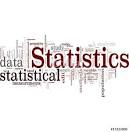WBCS Exe Etc Exam Main Optional Subject Statistics Syllabus
Paper – I :
Probability theory:
Definition of probability:
Classical and relative-frequency approach to probability, Kolmogorov’s Axiomatic definition (detailed discussion on discrete space only), limitations of Classical definition. Probability of union and intersection of events, Conditional probability and Independence of events, Bayes’ Theorem and its applications.Continue Reading WBCS Exe Etc Exam Main Optional Subject Statistics Syllabus
Random Variables :
Definition of discrete and continuous random variables, cumulative distribution function (c.d.f.) and its properties (with proof), probability mass function (p.m.f.) and probability density function (p.d.f.), Expectation and Moments, Joint distribution of two random variables, marginal and conditional distributions, Statistical Independence. Convergence in Probability, Weak Law of Large Numbers and its applications, Convergence in Distribution, Chebyshev’s inequality, Statement of Central Limit Theorem (i.i.d. case) & its applications.
Statistical Inference:
Point & Interval Estimations and Testing of Hypothesis:
Point estimation: Requirements of a good estimator – notions of Mean Square Error, Consistency, Unbiasedness: Minimum Variance Unbiasedness and Best Linear Unbiasedness. Sufficiency and factorization theorem, Rao-Balckwellisation, Methods of estimation- moments, least square, maximum likelihood and minimum chi-square
Elements of Hypothesis Testing :
Null and Alternative hypotheses, Simple and Composite hypotheses,
Critical Region, Type I and Type II Errors, Level of Significance and Size, p-value, Power. MP and UMP tests, Neyman Pearson lemma, Likelihood ratio tests. Interval Estimation: Confidence intervals, Concepts of Uniformly Most Accurate (UMA) confidence sets, relationship with tests of hypotheses.
Multivariate Analysis:
Multivariate data – multiple regression, multiple correlation and partial correlation – their properties and related results.
Random Vector:
Probability mass and density functions, Distribution Function, Mean vector and Dispersion matrix, Marginal and Conditional Distributions, Ellipsoid of Concentration, Multiple Regression, Multiple Correlation, Partial Correlation,Weak law of large numbers, Multonomial and Multivariate Normal Distributions.
Sample Survey:
Concepts of a Finite Population and a Sample, Need for Sampling, Complete Enumeration and Sample Surveys.
General Ideas:
Planning and execution of sample surveys, analysis of data and reporting, Biases and Errors. Judgement and probability sampling. Tables of Random Numbers and their uses Simple Random Sampling with and without replacement, Determination of sample size in simple random sampling, Stratified random sampling, Systematic sampling, Cluster and multistage sampling, ratio and regression methods of estimation.
Analysis of variance and Design of Experiments:
Heterogeneity and Analysis of Variance and Covariance, Linear Hypothesis, Orthogonal splitting of total variation, applications of the ANOVA technique to: one-way classified data, two-way classified data with equal number of observations per cell (fixed effects model only).Principles of experimental design: Randomization, Replication and Local Control, Continuous random variables , Uniformity trials, Shapes and Sizes of Plots and Blocks.
Standard Designs and their Analyses: Completely Randomized Design (CRD), Randomized Block Design (RBD) and Latin Square Design. Factorial Designs- 22 and 23 experiments.
Paper – II :
Industrial Statistics:
Introduction: Concepts of Quality and Quality Control, Process Control and Product Control. Process Control: Control Charts and their uses, Choice of Subgroup sizes, Construction of control charts by attributes (p, c, np) (including unequal subgroup size) and variables ( X , R). Interpretation of nonrandom patterns of points.
Product Control:
Producer’s Risk, Consumer’s Risk, Acceptance Sampling Plan, Single and Double sampling plans by attributes, their OC, ASN ( and ATI ), LTPD and AOQL , Sequential sampling plan- OC and ASN. Concept of Reliability, failure rate and reliability functions, reliability of series and parallel systems.
Economic Statistics:
Index Numbers: Price, Quantity and Value indices.
Price Index Numbers: Construction, Uses, Limitations, Tests for index numbers,Various formulae and their comparisons, Chain Index Number.
Some Important Indices: Consumer Price Index, Wholesale Price Index and Index of Industrial ,Production – methods of construction and uses.
Measurement of income inequality: Gini’s coefficient, Lorenz curves, Application of Pareto and Lognormal as income distributions.
Population Statistics:
Introduction: Sources of Population Data – Census data, Registration data and the errors in such data. Rates and ratios of vital events.
Measurements of Mortality:
Crude Death rate, Specific Death Rate, Standardized death Rate, Case fatality
rate and Cause of Death Rate, Infant Mortality Rate, Neonatal and Perinatal Mortality Rates. Life tables: Descriptions of Complete and Abridged Life Tables and their uses, Cohort vs. Current Life Tables, Stable population and Stationary population, Construction of complete life table from population and death statistics.
Measurements of Fertility:
Crude Birth Rate, General Fertility Rate, Age Specific Fertility Rate, Total
Fertility Rate. Growth Curve models.
Time Series Analysis:
Introduction: Examples of time series from various fields, Components of a times series, Additive and Multiplicative models.
Trend and Seasonal Components:
Estimation of trend by linear filtering (simple and weighted movingaverages) and curve fitting ( polynomial, exponential ), Estimation of seasonal component by ratio to moving-average method, ratio to trend method, some special processes-: Moving Average process, Auto Regressive processes of orders one and two, Exponential smoothing method of forecasting.
Linear Programming:
Formulation of LP problems, Simple LP model and its graphical solution, Simplex algorithm.
Official statistics:
The Statistical system in India: The Central and State Government organizations, the functions of the Central Statistical Organization (CSO), National Sample Survey Organization (NSSO) and West Bengal
Bureau of Applied Economics and Statistics.
National Income statistics: Income, expenditure and production approaches. Their applications in various sectors in India.
W.B.C.S. Main Examination 2019 Optional Statistics Question Paper I And II Download.
W.B.C.S. Main Optional Paper Statistics Book List
Worried about how to prepare Statistics Optional Subject for WBCS Main Exam?
Click here to see the strategy to score high in Statistics and Book List of Statistics Optional.
Our own publications are available at our webstore (click here).
For Guidance of WBCS (Exe.) Etc. Preliminary , Main Exam and Interview, Study Mat, Mock Test, Guided by WBCS Gr A Officers , Online and Classroom, Call 9674493673, or mail us at – mailus@wbcsmadeeasy.in
Please subscribe here to get all future updates on this post/page/category/website



 Toll Free 1800 572 9282
Toll Free 1800 572 9282  mailus@wbcsmadeeasy.in
mailus@wbcsmadeeasy.in


















































































































